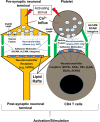Fresh Evidence for Platelets as Neuronal and Innate Immune Cells: Their Role in the Activation, Differentiation, and Deactivation of Th1, Th17, and Tregs during Tissue Inflammation
- PMID: 29599771
- PMCID: PMC5863511
- DOI: 10.3389/fimmu.2018.00406
Fresh Evidence for Platelets as Neuronal and Innate Immune Cells: Their Role in the Activation, Differentiation, and Deactivation of Th1, Th17, and Tregs during Tissue Inflammation
Abstract
Recent studies suggest that in addition to their common function in the regulation of thrombosis and hemostasis, platelets also contribute to tissue inflammation affecting adaptive immunity. Platelets have a number of pro-inflammatory and regulatory mediators stored in their α-granules and dense granules, which are promptly released at sites of inflammation or tissue injury. Platelet-derived mediators include cytokines (IL-1α, IL-1β, and TGFβ1), chemokines (CXCL4 and CCL3), immunomodulatory neurotransmitters (serotonin, dopamine, epinephrine, histamine, and GABA), and other low-molecular-weight mediators. In addition, activated platelets synthesize a number of lipid pro-inflammatory mediators such as platelet-activating factor and prostaglandins/thromboxanes. Notably, platelets express multiple toll-like receptors and MHC class I on their surface and store IgG in their α-granules. Platelet-derived factors are highly effective in directly or indirectly modulating the priming and effector function of various subsets of T cells. Besides secreting soluble factors, activated platelets upregulate a number of integrins, adhesion molecules, and lectins, leading to the formation of platelet-T cells aggregates. Activated platelets are able to instantly release neurotransmitters acting similar to neuronal presynaptic terminals, affecting CD4 T cells and other cells in close contact with them. The formation of platelet-T cell aggregates modulates the functions of T cells via direct cell-cell contact interactions and the local release of soluble factors including neurotransmitters. New data suggest an important role for platelets as neuronal and innate-like cells that directly recognize damage- or pathogen- associated molecular patterns and instantly communicate with T cells.
Keywords: CD4 T cells; autoimmunity; damage-associated molecular pattern; glycolipids; inflammation; neurotransmitter; platelets.
Figures

Similar articles
-
Platelets regulate CD4⁺ T-cell differentiation via multiple chemokines in humans.Thromb Haemost. 2011 Aug;106(2):353-62. doi: 10.1160/TH11-01-0020. Epub 2011 Jun 9. Thromb Haemost. 2011. PMID: 21655676
-
Important roles of platelets as immune cells in the skin.J Dermatol Sci. 2015 Feb;77(2):93-101. doi: 10.1016/j.jdermsci.2014.10.003. Epub 2014 Oct 18. J Dermatol Sci. 2015. PMID: 25459165 Review.
-
Platelets and autoimmunity.Eur J Clin Invest. 2013 Jul;43(7):746-57. doi: 10.1111/eci.12101. Epub 2013 Apr 26. Eur J Clin Invest. 2013. PMID: 23617819 Review.
-
Serotonin decreases the production of Th1/Th17 cytokines and elevates the frequency of regulatory CD4+ T-cell subsets in multiple sclerosis patients.Eur J Immunol. 2018 Aug;48(8):1376-1388. doi: 10.1002/eji.201847525. Epub 2018 Jun 6. Eur J Immunol. 2018. PMID: 29719048
-
Mast cells as effector cells of innate immunity and regulators of adaptive immunity.Immunol Lett. 2016 Oct;178:10-4. doi: 10.1016/j.imlet.2016.07.003. Epub 2016 Jul 5. Immunol Lett. 2016. PMID: 27393494 Review.
Cited by
-
Of vascular defense, hemostasis, cancer, and platelet biology: an evolutionary perspective.Cancer Metastasis Rev. 2022 Mar;41(1):147-172. doi: 10.1007/s10555-022-10019-5. Epub 2022 Jan 12. Cancer Metastasis Rev. 2022. PMID: 35022962 Free PMC article. Review.
-
The role of Mean Platelet Volume/platelet count Ratio and Neutrophil to Lymphocyte Ratio on the risk of Febrile Seizure.Sci Rep. 2018 Oct 11;8(1):15123. doi: 10.1038/s41598-018-33373-3. Sci Rep. 2018. PMID: 30310107 Free PMC article.
-
Human platelet lysate: a potential therapeutic for intracerebral hemorrhage.Front Neurosci. 2025 Jan 15;18:1517601. doi: 10.3389/fnins.2024.1517601. eCollection 2024. Front Neurosci. 2025. PMID: 39881806 Free PMC article. Review.
-
The Predictive Value of Hemocytometry Based on Peripheral Platelet-Related Parameters in Identifying the Causes of Febrile Seizures.J Inflamm Res. 2021 Oct 18;14:5381-5392. doi: 10.2147/JIR.S334165. eCollection 2021. J Inflamm Res. 2021. PMID: 34703275 Free PMC article.
-
Effects of the interactions between platelets with other cells in tumor growth and progression.Front Immunol. 2023 Apr 17;14:1165989. doi: 10.3389/fimmu.2023.1165989. eCollection 2023. Front Immunol. 2023. PMID: 37153586 Free PMC article. Review.
References
Publication types
MeSH terms
LinkOut - more resources
Full Text Sources
Other Literature Sources
Research Materials
Miscellaneous

